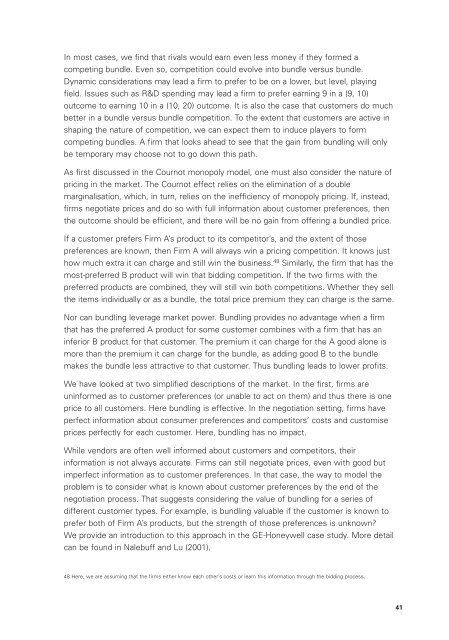Bundling, Tying, and Portfolio Effects: Part 1 Conceptual Issues
Bundling, Tying, and Portfolio Effects: Part 1 Conceptual Issues
Bundling, Tying, and Portfolio Effects: Part 1 Conceptual Issues
Create successful ePaper yourself
Turn your PDF publications into a flip-book with our unique Google optimized e-Paper software.
In most cases, we find that rivals would earn even less money if they formed a<br />
competing bundle. Even so, competition could evolve into bundle versus bundle.<br />
Dynamic considerations may lead a firm to prefer to be on a lower, but level, playing<br />
field. <strong>Issues</strong> such as R&D spending may lead a firm to prefer earning 9 in a (9, 10)<br />
outcome to earning 10 in a (10, 20) outcome. It is also the case that customers do much<br />
better in a bundle versus bundle competition. To the extent that customers are active in<br />
shaping the nature of competition, we can expect them to induce players to form<br />
competing bundles. A firm that looks ahead to see that the gain from bundling will only<br />
be temporary may choose not to go down this path.<br />
As first discussed in the Cournot monopoly model, one must also consider the nature of<br />
pricing in the market. The Cournot effect relies on the elimination of a double<br />
marginalisation, which, in turn, relies on the inefficiency of monopoly pricing. If, instead,<br />
firms negotiate prices <strong>and</strong> do so with full information about customer preferences, then<br />
the outcome should be efficient, <strong>and</strong> there will be no gain from offering a bundled price.<br />
If a customer prefers Firm A’s product to its competitor’s, <strong>and</strong> the extent of those<br />
preferences are known, then Firm A will always win a pricing competition. It knows just<br />
how much extra it can charge <strong>and</strong> still win the business. 48 Similarly, the firm that has the<br />
most-preferred B product will win that bidding competition. If the two firms with the<br />
preferred products are combined, they will still win both competitions. Whether they sell<br />
the items individually or as a bundle, the total price premium they can charge is the same.<br />
Nor can bundling leverage market power. <strong>Bundling</strong> provides no advantage when a firm<br />
that has the preferred A product for some customer combines with a firm that has an<br />
inferior B product for that customer. The premium it can charge for the A good alone is<br />
more than the premium it can charge for the bundle, as adding good B to the bundle<br />
makes the bundle less attractive to that customer. Thus bundling leads to lower profits.<br />
We have looked at two simplified descriptions of the market. In the first, firms are<br />
uninformed as to customer preferences (or unable to act on them) <strong>and</strong> thus there is one<br />
price to all customers. Here bundling is effective. In the negotiation setting, firms have<br />
perfect information about consumer preferences <strong>and</strong> competitors’ costs <strong>and</strong> customise<br />
prices perfectly for each customer. Here, bundling has no impact.<br />
While vendors are often well informed about customers <strong>and</strong> competitors, their<br />
information is not always accurate. Firms can still negotiate prices, even with good but<br />
imperfect information as to customer preferences. In that case, the way to model the<br />
problem is to consider what is known about customer preferences by the end of the<br />
negotiation process. That suggests considering the value of bundling for a series of<br />
different customer types. For example, is bundling valuable if the customer is known to<br />
prefer both of Firm A’s products, but the strength of those preferences is unknown?<br />
We provide an introduction to this approach in the GE-Honeywell case study. More detail<br />
can be found in Nalebuff <strong>and</strong> Lu (2001).<br />
48 Here, we are assuming that the firms either know each other’s costs or learn this information through the bidding process.<br />
41

















